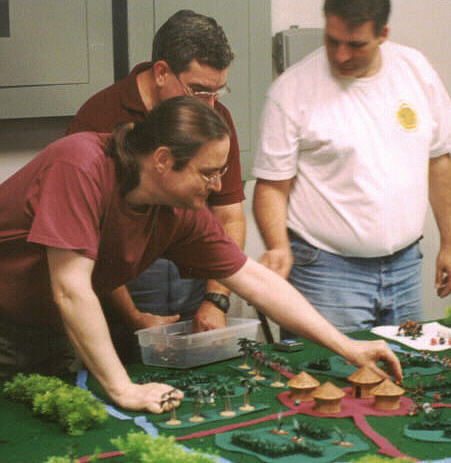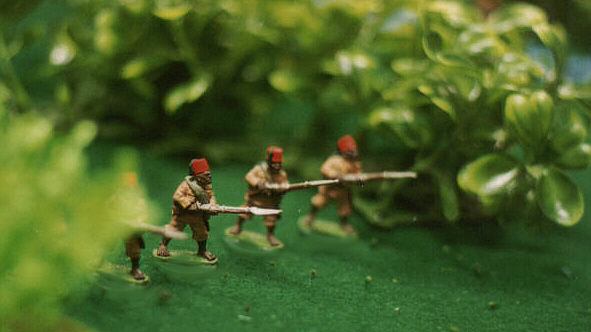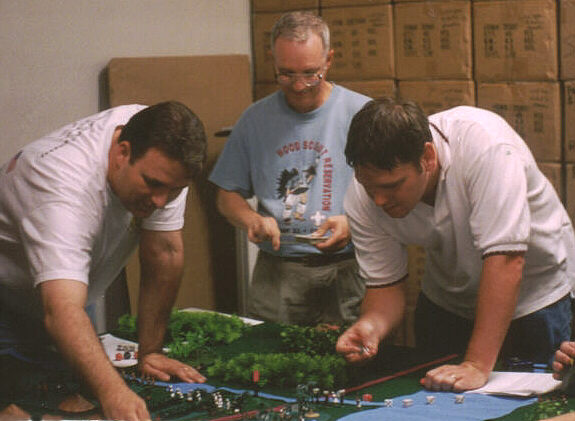

The Lion and the Gazelle!
Our game of August 16, 2003
"When the lion wakes up in the morning, he knows that he must be the fastest runner in order to chase down his prey to eat and survive. When the gazelle wakes up in the morning, he knows that he must be faster than the lion in order to survive. So no matter which you are, lion or gazelle, when the sun comes up you had better be running - fast!" An Old African proverb.

The map of the table. The British and their native troops approached from the right hand side, but made a long detour with most of their forces around the large lake to move against the village from the top of the map.
The Great Mamubaba lead her reinforceing army to aid Lolomango, moving up from the bottom of the map.
 | Cultivated areas |
 | Heavy jungle patches |
 | Trails |
 | Streams |
 | Palm tree lines |
 | The village |
Chief Lolomango and his sleepy village appear to be the flock of sheep as the government wolf descends upon them. But are the villagers a herd of sheep? Rumors have been heard around the bush telegraph that Chief Lolomango has sworn fealty to a mysterious woman warrior known as the Great Mamubaba. She is supposedly leading a great army to aid Lolomango in overpowering the government forces.

Phil Young reaches in Front of Ed Sansing to move his native troops out of concealment. Ed is bringing figures onto the board also. Jim Woodrick (in white shirt) offers a few pieces of advice.
The sleepy village of Umbangomango swelters in the humid heat of an African summer. The peaceful villagers go about their daily tasks - farming, cooking, washing, herding their livestock - unaware that fate has a cruel twist in mind for them. Somehow word has been passed back to the territorial administrators that Umbangomango is a hotbed of insurrectionists, intent on destabilizing the British rule in the Colony of Lower Bongowongo. A punitive expedition, commanded by Captain Smedley Bryce-Hopkins, is even now on its way to punish these wayward heathens.

The British-led native Askari troopers have formed with their back to the wall. They have beaten off two attacks already and the brush rustles with concealed native warriors.

A unit of "white hunters" follow behind Askaris followed, in turn, by bearers with supplies and ammunition.
The Government forces' victory conditions included Capturing the Village, arresting Lolomango, his son, the Great Mamubaba or other insurrectionist leaders. also victory dice would be awarded for units destroyed or caused to flee battlefield.

The Askaris send back word, "All is quiet. Too quiet!"
Native Victory Conditions awarded victory dice for retaining control of the village at the end of the game, for every unit of government troops who were destroyed or forced to flee the battlefield, and for capturing government leaders or the government bearers.
The Game Master reserved the right to impose other victory dice additions and decrements for acts of derring-do, heroism, or cravenly actions.
THE PLAYERS
Native players
| Government Men
|
The GAMEMASTER Jim Pitts (He who MUST be obeyed!)

A band of the Great Mamubaba's warriors race down the paths between the dense jungle. This area was as foreign to her warriors as it was to the white men and thier troops. Only Chief Lolomango's men know this area and cam move freely through it.

Jim Woodrick (on left) and Justin Rice (on right) get very exact about the placement of units. Jim Pitts (Game master) looks on with fiendish glee.

The British officer urges his askaris to "hold them - HOLD THEM!". Native spearman have 'rounded the corner' on an impassible patch of saw grass and rushed stright into the askari.

More natives come out of the rear of an overgrown area into the rear of a rugga-rugga musket unit. Too bad for the poor rugga-rugga!
A Note on rules
We used Larry Brom's The Sword in Africa rules which is bound into The Sword and The Flame - 20th Anniversary Edition. During the game, a rules question came up when a unit of Askaris charged into the brush to find and punish a unit of the great Mamubaba's warriors. Jay Stribling argued that the warriors would counter-charge - which is allowable in TSATF-20.
Mark Stevens argued that this was not so. That the warriors could have charged if they had moved first, but now were "stuck" and had to accept the charge, being able to neither withdraw or countercharge. Gamemaster Jim Pitts accepted (logically - I thought) Jay's argument.
After the game, Mark Stevens appealed to a higher court. Via email, the great white cheiftain in North Carolina, Larry Brom, rendered his verdict: The warriors could have charged or withdrawn if they had moved first, but now WERE "stuck" and had to accept the charge, being able to neither withdraw or countercharge!
Fortunately for Stribling, the game was long over by that time!
Who Won the Game?
The Natives won. They held the village which turned out to be the most important posession in the game. Had the white men and their puppet troops known this, they might have been able to use cannon to destroy the huts - but NO.
There may be more photos yet to digitize and post
Return to the Master Index of Photos and Games
Return to the Jackson Gamers' Homepage
Angelfire - Free Home Pages
Free Web Building Help
Angelfire HTML Library
htmlGEAR - free polls, guestbooks, and more!
Thank you for visiting The Jackson Gamers' pages at Angelfire. Please come back and visit again!